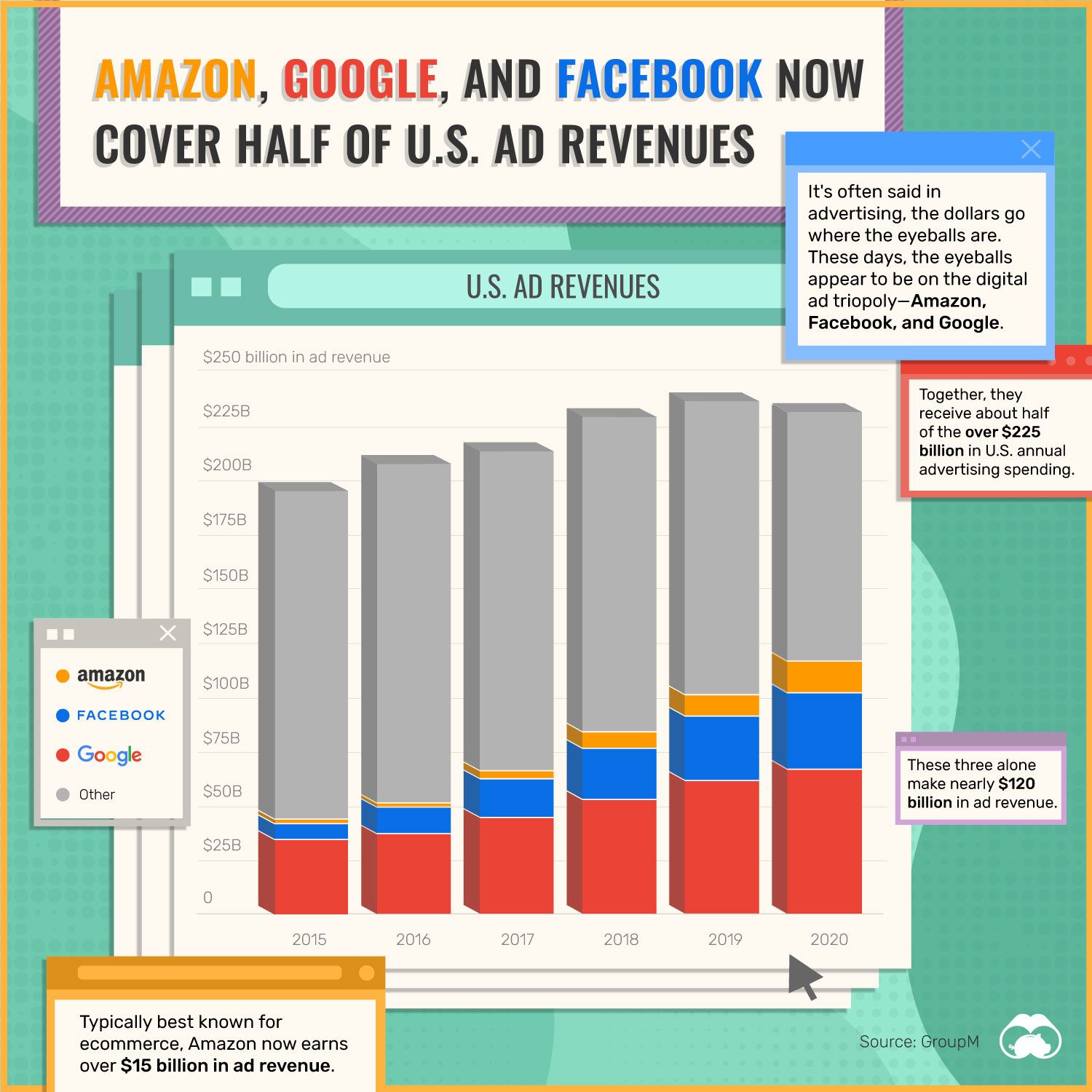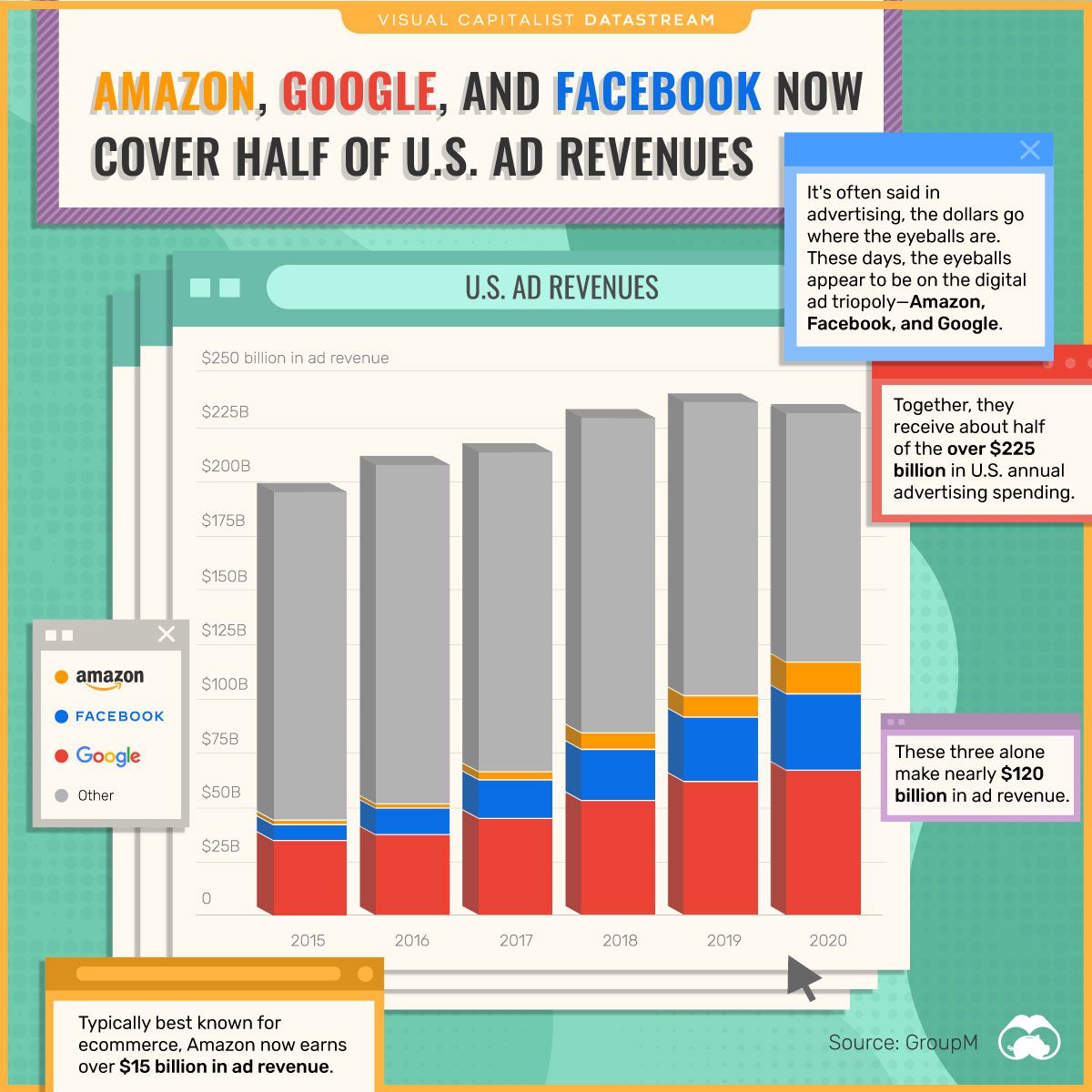Datastream
3 Companies Now Make Up 50% of U.S. Ad Revenues

The Briefing
- Collectively, Amazon, Facebook, and Google make over $112 billion in advertising revenues
- Two-thirds of ads in the U.S. are now digital
3 Companies Now Make Up 50% of U.S. Ad Revenues
Every year in the U.S., CFOs and marketing executives gather to allocate a portion of company funds towards advertising budgets. Today, on average, over half of those U.S. ad dollars end up in the deep pockets of just three tech stocks—Amazon, Google, and Facebook.
The advertising landscape is changing beyond recognition. Today’s data takes a closer look at annual U.S. advertising dollars, where Big Tech stocks continue to grow their presence.
The Ad Dollars in 2020
The U.S. is home to some of the biggest advertising spenders in the world. Despite a decline due to the COVID-19 pandemic, U.S. advertising spend was worth just over $225 billion in 2020.
The Big Tech ad triopoly made roughly $120 billion of this, and are taking up more market share with every year. One reason for this is the industry’s move towards digital ads, which now make up almost two-thirds of all ad spending.
An Unlikely Competitor
Big Tech stocks like Google and Facebook are well known pure plays on the advertising space. However, Amazon’s inclusion may come as a surprise. Typically known for their ecommerce business, Amazon now also makes over $16 billion in ad revenue each year.
But it wasn’t always like this. Prior to 2015, the digital ad space was a duopoly consisting of just Facebook and Google. At the time, Amazon ad revenues were relatively minuscule, totaling under $1 billion.
Here’s a closer look at those ad revenues over time:
| Year | Ad Revenue ($B) | % Change |
|---|---|---|
| 2022P | $20.07 | 23% |
| 2021P | $16.32 | 28% |
| 2020 | $12.75 | 23% |
| 2019 | $10.32 | 39% |
| 2018 | $7.41 | 122% |
If these trends serve as any indication, advertising budgets will only be skewing more digital, and the ad triopoly will continue to command a larger share with time.
Where does this data come from?
Source: GroupM
Notes: Amazon ad revenues are estimates from the “Other” category of their reported revenues
Datastream
Can You Calculate Your Daily Carbon Footprint?
Discover how the average person’s carbon footprint impacts the environment and learn how carbon credits can offset your carbon footprint.

The Briefing
- A person’s carbon footprint is substantial, with activities such as food consumption creating as much as 4,500 g of CO₂ emissions daily.
- By purchasing carbon credits from Carbon Streaming Corporation, you can offset your own emissions and fund positive climate action.
Your Everyday Carbon Footprint
While many large businesses and countries have committed to net-zero goals, it is essential to acknowledge that your everyday activities also contribute to global emissions.
In this graphic, sponsored by Carbon Streaming Corporation, we will explore how the choices we make and the products we use have a profound impact on our carbon footprint.
Carbon Emissions by Activity
Here are some of the daily activities and products of the average person and their carbon footprint, according to Clever Carbon.
| Household Activities & Products | CO2 Emissions (g) |
|---|---|
| 💡 Standard Light Bulb (100 watts, four hours) | 172 g |
| 📱 Mobile Phone Use (195 minutes per day)* | 189 g |
| 👕 Washing Machine (0.63 kWh) | 275 g |
| 🔥 Electric Oven (1.56 kWh) | 675 g |
| ♨️ Tumble Dryer (2.5 kWh) | 1,000 g |
| 🧻 Toilet Roll (2 ply) | 1,300 g |
| 🚿 Hot Shower (10 mins) | 2,000 g |
| 🚙 Daily Commute (one hour, by car) | 3,360 g |
| 🍽️ Average Daily Food Consumption (three meals of 600 calories) | 4,500 g |
| *Phone use based on yearly use of 69kg per the source, Reboxed | |
Your choice of transportation plays a crucial role in determining your carbon footprint. For instance, a 15 km daily commute to work on public transport generates an average of 1,464 g of CO₂ emissions. Compared to 3,360 g—twice the volume for a journey the same length by car.
By opting for more sustainable modes of transport, such as cycling, walking, or public transportation, you can significantly reduce your carbon footprint.
Addressing Your Carbon Footprint
One way to compensate for your emissions is by purchasing high-quality carbon credits.
Carbon credits are used to help fund projects that avoid, reduce or remove CO₂ emissions. This includes nature-based solutions such as reforestation and improved forest management, or technology-based solutions such as the production of biochar and carbon capture and storage (CCS).
While carbon credits offer a potential solution for individuals to help reduce global emissions, public awareness remains a significant challenge. A BCG-Patch survey revealed that only 34% of U.S. consumers are familiar with carbon credits, and only 3% have purchased them in the past.
About Carbon Streaming
By financing the creation or expansion of carbon projects, Carbon Streaming Corporation secures the rights to future carbon credits generated by these sustainable projects. You can then purchase these carbon credits to help fund climate solutions around the world and compensate for your own emissions.
Ready to get involved?
>> Learn more about purchasing carbon credits at Carbon Streaming
-

 Markets1 week ago
Markets1 week agoU.S. Debt Interest Payments Reach $1 Trillion
-

 Markets2 weeks ago
Markets2 weeks agoRanked: The Most Valuable Housing Markets in America
-

 Money2 weeks ago
Money2 weeks agoWhich States Have the Highest Minimum Wage in America?
-

 AI2 weeks ago
AI2 weeks agoRanked: Semiconductor Companies by Industry Revenue Share
-

 Markets2 weeks ago
Markets2 weeks agoRanked: The World’s Top Flight Routes, by Revenue
-

 Countries2 weeks ago
Countries2 weeks agoPopulation Projections: The World’s 6 Largest Countries in 2075
-

 Markets2 weeks ago
Markets2 weeks agoThe Top 10 States by Real GDP Growth in 2023
-

 Money2 weeks ago
Money2 weeks agoThe Smallest Gender Wage Gaps in OECD Countries


















